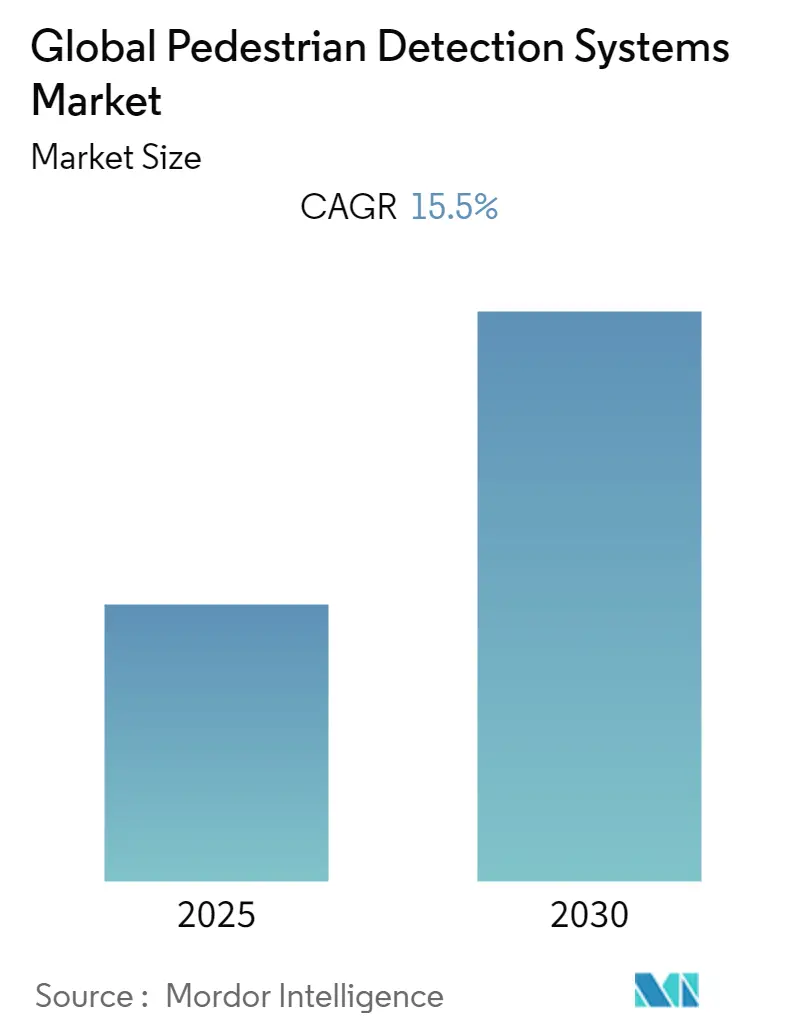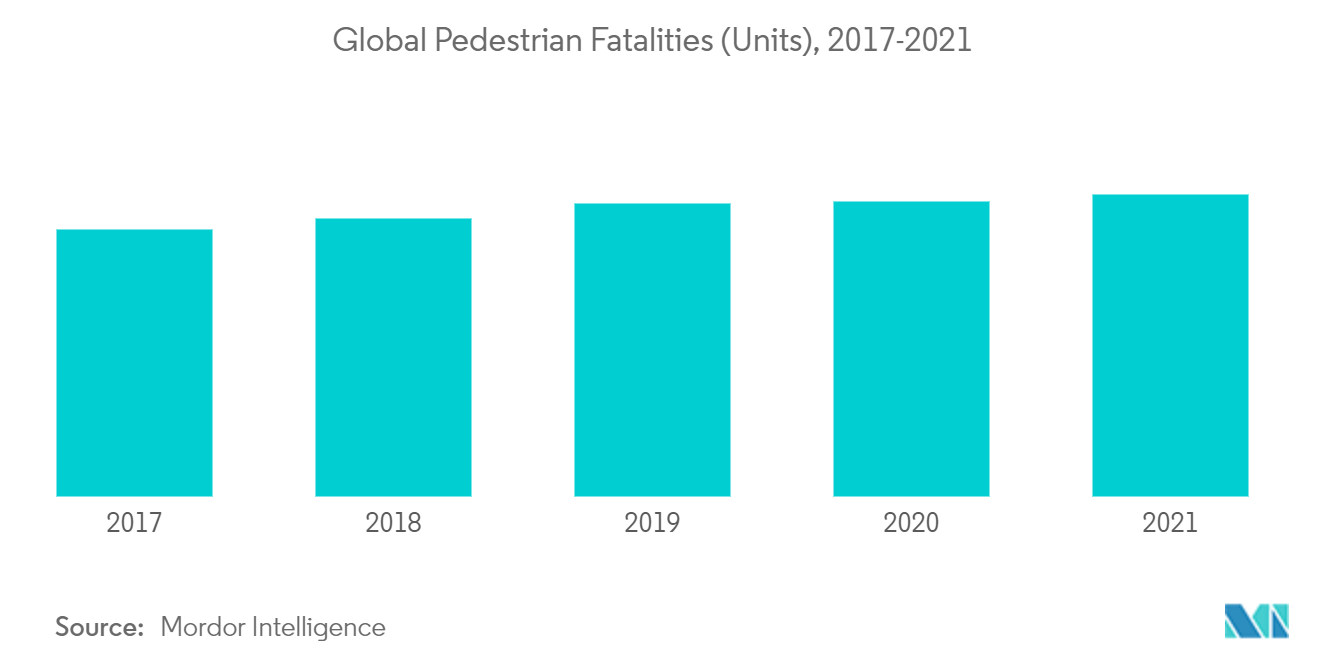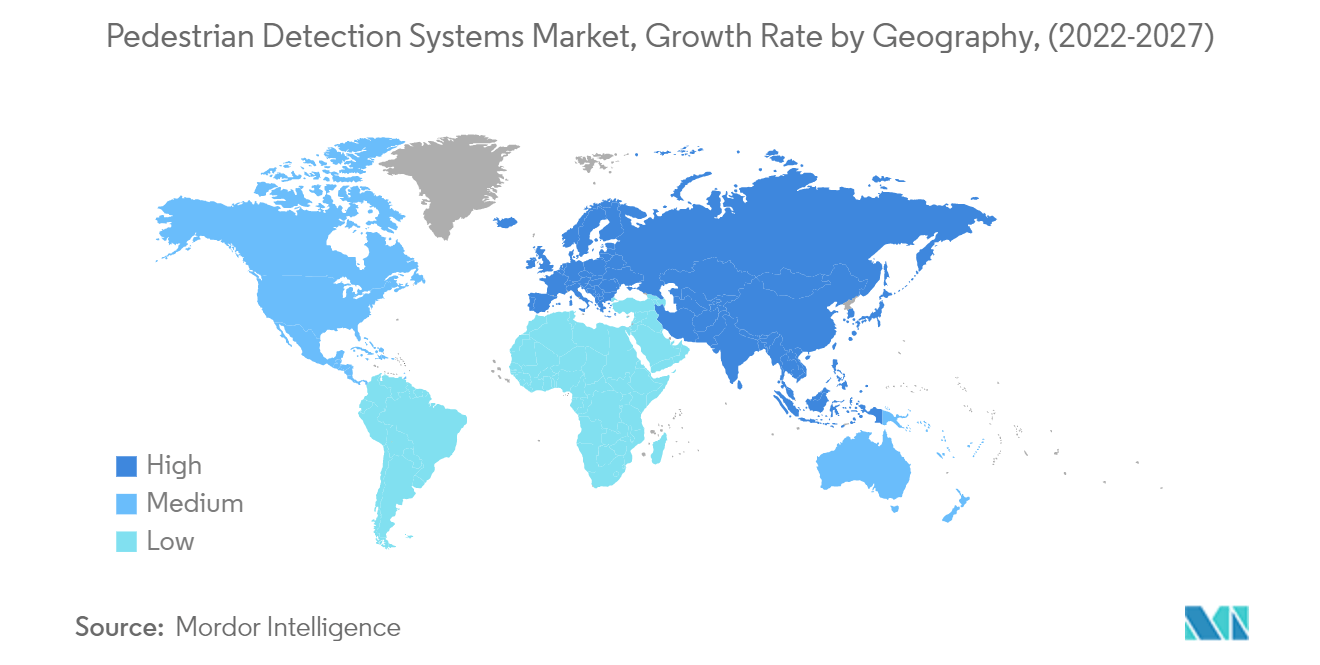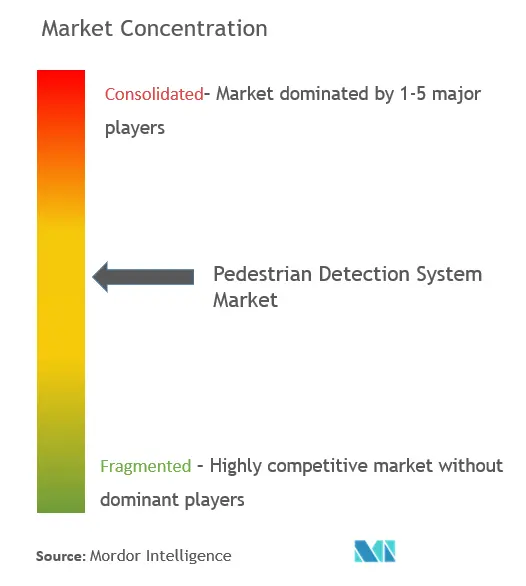
Pedestrian Detection Systems Market Analysis
The Global Pedestrian Detection Systems Market is expected to register a CAGR of 15.5% during the forecast period.
The COVID-19 pandemic had a massive impact on the market studied as lockdowns and trade restrictions have led to supply chain disruptions and a halt of vehicle production across the world. However, as restrictions eased, players started focusing on mitigating such risks and developments to create momentum in the market during the forecast period.
Over the medium term, Growing production of vehicles with integrated ADAS features in the wake of rising awareness toward comfort and safety of passengers and government regulations mandating safety features are expected to drive demand in the market.
The pedestrian detection system is an essential component of the driver assistance system, which is developed to avoid collisions between vehicles and pedestrians, especially while driving at night-time. The night-time pedestrian detection systems work by letting the driver of the vehicle know about the obstacles on the road, with the help of a near-infrared (NIR) camera and its displaying unit.
Some of the major factors driving the growth of the market studied are the growing emphasis on the safety of passengers and pedestrians, owing to a rise in the number of accidents and the increasing demand for premium vehicles. However, factors, such as difficulty in detecting pedestrians during bad weather conditions, may hinder the growth of the market studied.
In recent years, the automobile industry has motivated its R&D work to improve night vision systems. This has led to further improvements in advanced driving assistance systems, with the surge in demand for night-time pedestrian detection systems. Low penetration of leading providers of advanced driving assistance systems (ADASs) in the emerging markets and the rise in the number of autonomous cars are reasons for the opportunities present in the market studied.
Pedestrian Detection Systems Market Trends
Increase in the Number of Road Fatalities
The rise in the number of accidents, resulting in loss of lives and properties across the world, is being considered one of the major factors driving the demand for and development of advanced automobile safety systems. As consumers are gaining awareness about the advanced safety features and technologies, they are indicating an interest in improving their vehicles' safety systems.
As per the WHO, more than half of all road traffic deaths are among vulnerable road users, such as pedestrians, cyclists, and motorcyclists. Deaths of pedestrians and cyclists accounted for 26% of all deaths, while that of those using motorized two- and three-wheelers accounted for 28%.
Thus, the number of pedestrians hit and killed has been continually increasing. For instance -
- According to a preliminary estimate published by the Governors Highway Safety Association (GHSA), in the first half of 2021, in the United States, 2957 pedestrians were killed in road fatalities, a 54% increase, compared to 2020.
- Five states in the country, namely, Arizona, California, Florida, Georgia, and Texas, accounted for 46% of all pedestrian deaths, despite representing only 33% of the US population, according to Census data. California recorded the largest number of pedestrian deaths, at 432.
- According to National Highway Traffic Safety Administration, 42,915 people died in motor vehicle traffic crashes in 2021, a 10.5% increase from the 38,824 fatalities in 2020.
- Regions, such as Europe and North America, are developed, and with the increase in vehicle sales, more customers are opting for trending ADAS features in their vehicles, owing to the need for safety and comfort features.
Initially, the majority of the consumers did not adopt these systems due to the high cost and lack of awareness. However, with the new government regulations in place and the proven safety benefits, these systems have gained consumer interest. The ongoing installations are being done by both OEMs and aftermarkets, to facilitate end users with ADAS features.

Europe is Expected to Witness High Adoption Rate
In 2021, around 25% of all people killed on roads were pedestrians. In general, pedestrian fatalities have decreased at a lower rate than for other road users (by 15% from 2010 to 2020, compared to a total fatality decrease of 20%).
The European Commission has made it mandatory for all new cars to be equipped with safety equipment by 2021. The commission wants to fit all the 11 various ADAS features designed to prevent or mitigate accidents. The European Union anticipates that the addition of these 11 ADAS safety features may not only save over 7,000 lives across Europe but may also prevent 38,000 serious injuries between 2020 and 2030.
- In March 2019, EU institutions agreed on the revision of the General Safety Regulation that may make many vehicle safety measures mandatory from 2022 in vehicles across EU countries. The new proposal is expected to save over 25,000 lives and prevent 140,000 serious injuries by 2038, in line with 'Vision Zero,' which aims to achieve the target of zero fatalities and serious injuries by 2050.
The vehicle safety measures that have direct relevance to the cyclists' and pedestrians' safety include Intelligent Speed Assistance, Autonomous Emergency Braking (AEB) for the car to pedestrian/cyclist and HGV/truck 'VRU detection' assist, which may warn the driver if a pedestrian or cyclist is in the blind spot of a large vehicle (in the review of the General Safety Regulation and the Pedestrian Safety Regulation, under the Third 'Europe on the Move' set of actions).
In Europe, Germany is expected to be one of the major markets. With the growing focus on both passengers' safety and pedestrians' and cyclists' safety, the demand for advanced driver's safety assistance systems of collision warning systems has been continually increasing.
- In July 2022, the Federal Statistical Office reported, 321 people were killed in road traffic accidents in Germany. An increase in the number of death was the result of the rise in deaths of cyclists and motorcyclists. However, the country witnessed a decline in the number of pedestrian deaths by approximately 6%.
Irrespective of the decline in the number of pedestrian deaths, the country has been striving to further reduce pedestrian and cyclist fatalities, and the announcement of the revision of the General Safety Regulations may further aid in reducing the fatalities.
To reduce the number of accidents and fatalities, the department of transportation has made it compulsory to incorporate a forward collision avoidance technology systems in vehicles from 2017 onward. This system is a combination of long-range detection (e.g., adaptive cruise control), short-range and wide-angle systems (e.g., pedestrian detection), and autonomous emergency braking. This regulation is anticipated to drive the market for pedestrian detection systems in the country during the forecast period.

Pedestrian Detection Systems Industry Overview
The market is majorly concentrated, with few players dominating the market. However, there are some auto manufacturers, such as BMW and Toyota Motor Corporation, who are supplying their manufactured pedestrian detection systems. Some of the major players in the pedestrian detection system are Denso Corporation, Continental AG, Valeo SA, Robert Bosch, ZF Friedrichshafen AG, and Many others.
Several players are partnering to enhance their research and development facilities and expand their manufacturing facilities across the globe, which is likely to witness major growth for the market during the forecast period. For instance,
- In August 2022, ZF Asia Pacific Group Co., Ltd. signed an agreement with the Management Committee of Zhangjiagang Economic and Technological Development Zone for an expansion of manufacturing facilities across the Zhangjiagang base. Under this agreement, ZF invested USD 100 Million to focus on the production of braking systems, passive safety systems, electric steering systems, and chassis components, respectively.
- In March 2022, ZF Friedrichshafen AG acquired Stradvision, a leading provider of artificial intelligence-based vision processing technology for autonomous vehicles and ADAS systems. Through this acquisition, ZF accelerates its autonomous vehicle offerings and is working towards making them safe by reliably detecting and identifying other road users, road markings, or traffic signs, even in harsh weather conditions or poor lighting.
- In February 2022, Robert Bosch invested INR 2,000 Crore for the expansion of manufacturing facilities across India. The new facility would be primarily in advanced automotive technologies and digital mobility space.
- In February 2022, Denso Corporation invested USD 350 Million to take a minority stake in Japan Advanced Semiconductor Manufacturing, Inc. (JASM), Taiwan Semiconductor Manufacturing Company Limited's (TSMC's) majority-owned manufacturing subsidiary in Japan.
Pedestrian Detection Systems Market Leaders
-
DENSO Corporation
-
ZF Friedrichshafen AG
-
Robert Bosch GmbH
-
Continental AG
-
Valeo SA
- *Disclaimer: Major Players sorted in no particular order
Pedestrian Detection Systems Market News
- In September 2022, Denso Corporation introduced the detection angle of its vision sensor, increasing the sensor's ability to recognize pedestrians and bicycles around a vehicle to improve road safety.
- In March 2022, Continental AG and Autobrain jointly developed a single optical camera sensor. The new camera sensor can recognize lane markings, the road edge, other vehicles, pedestrians, and more.
- In September 2021, ZF Friedrischafen AG introduced High-Performance Mid-Range Radar to support advanced ADAS safety functions. Mid-Range Radar support features like pedestrian automatic emergency braking (AEB) to long-range object detection at high speeds to enhance driving functions like adaptive cruise control (ACC).
Pedestrian Detection Systems Industry Segmentation
The pedestrian detection system is an advanced driver safety assistance system, which aids in avoiding collisions. It is an essential component in any intelligent video surveillance system, as it provides the fundamental information for semantic understanding of the video footage.
The pedestrian detection system market is segmented by type, component, and geography.
Based on the type, the market is segmented into Video, Infrared, Hybrid, and Other Types.
Based on the component, the market is segmented into sensors, Cameras, Radar, and Others.
Based on geography, the market is segmented into North America, Europe, Asia-Pacific, and the Rest of the World.
For each segment, the market sizing and forecast have been done on the basis of value (USD Million).
| Type | Video | ||
| Infrared | |||
| Hybrid | |||
| Other Types | |||
| Component | Sensor | ||
| Camera | |||
| Radar | |||
| Others | |||
| Geography | North America | United States | |
| Canada | |||
| Rest of North America | |||
| Europe | Germany | ||
| United Kingdom | |||
| France | |||
| Spain | |||
| Italy | |||
| Russia | |||
| Rest of Europe | |||
| Asia-Pacific | China | ||
| Japan | |||
| India | |||
| South Korea | |||
| Rest of Asia-Pacific | |||
| Rest of the World | Brazil | ||
| Saudi Arabia | |||
| Other Countries | |||
Pedestrian Detection Systems Market Research FAQs
What is the current Global Pedestrian Detection Systems Market size?
The Global Pedestrian Detection Systems Market is projected to register a CAGR of 15.5% during the forecast period (2025-2030)
Who are the key players in Global Pedestrian Detection Systems Market?
DENSO Corporation, ZF Friedrichshafen AG, Robert Bosch GmbH, Continental AG and Valeo SA are the major companies operating in the Global Pedestrian Detection Systems Market.
Which is the fastest growing region in Global Pedestrian Detection Systems Market?
Europe is estimated to grow at the highest CAGR over the forecast period (2025-2030).
Which region has the biggest share in Global Pedestrian Detection Systems Market?
In 2025, the Asia-Pacific accounts for the largest market share in Global Pedestrian Detection Systems Market.
What years does this Global Pedestrian Detection Systems Market cover?
The report covers the Global Pedestrian Detection Systems Market historical market size for years: 2019, 2020, 2021, 2022, 2023 and 2024. The report also forecasts the Global Pedestrian Detection Systems Market size for years: 2025, 2026, 2027, 2028, 2029 and 2030.
Our Best Selling Reports
Global Pedestrian Detection Systems Industry Report
Statistics for the 2025 Global Pedestrian Detection Systems market share, size and revenue growth rate, created by Mordor Intelligence™ Industry Reports. Global Pedestrian Detection Systems analysis includes a market forecast outlook for 2025 to 2030 and historical overview. Get a sample of this industry analysis as a free report PDF download.




